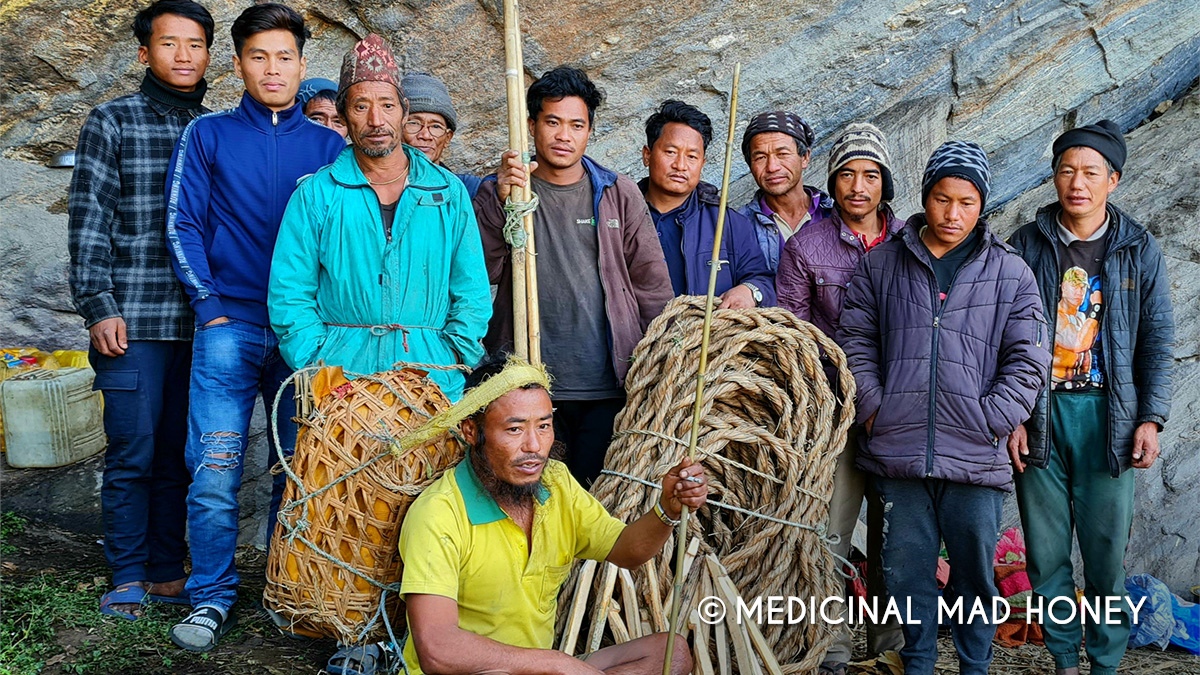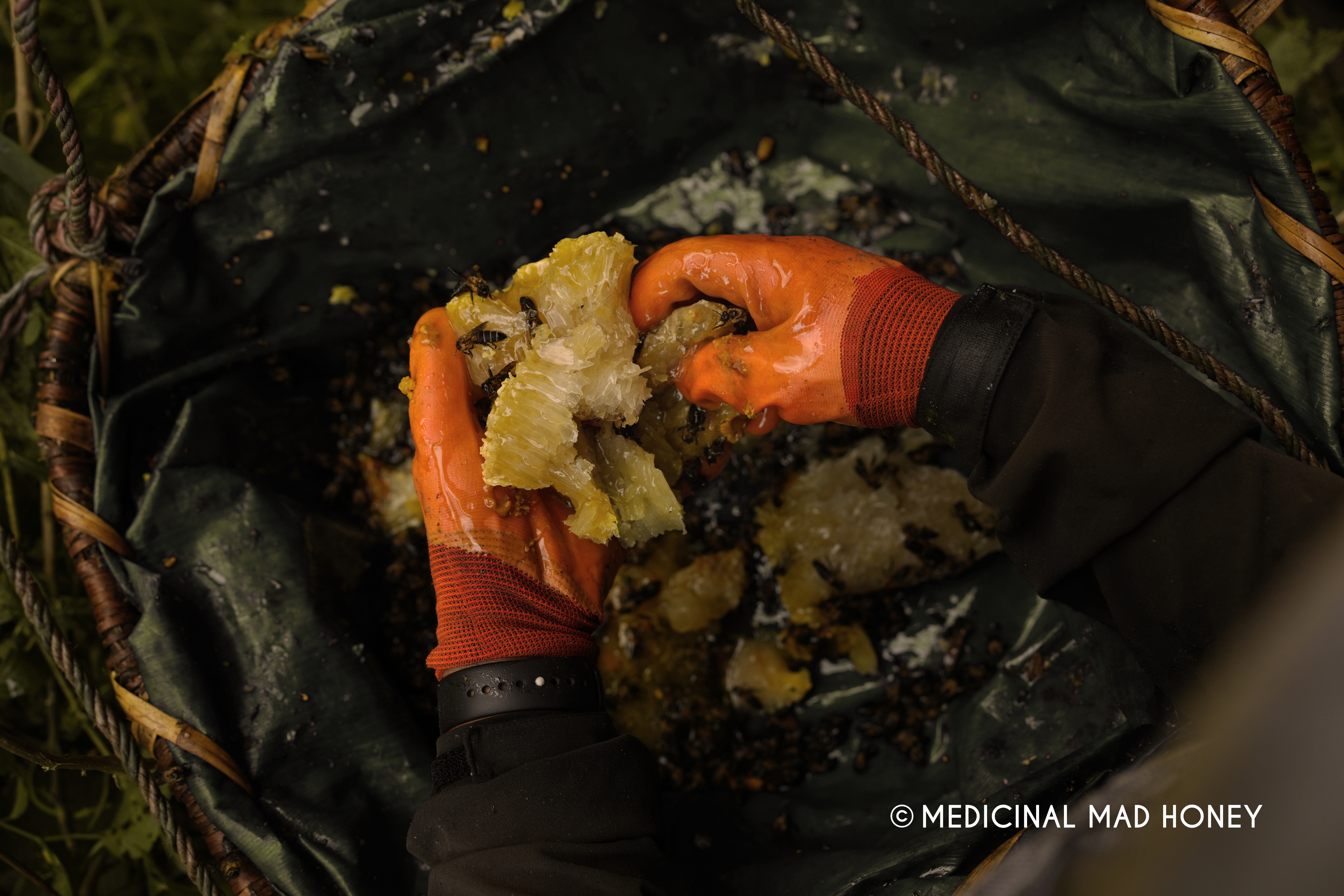Apis Laboriosa: The Himalayan Pollinators from Nepal by Rashmi Kandel, Medicinal Mad Honey, Guest Author
Published May 20th, 2025
When we think of pollinators, our minds often go to the familiar, honey bees buzzing around garden blooms and butterflies flapping their colourful wings over sun-drenched meadows. But the world of pollinators is boundless, wild, and often hidden in plain sight.
Likewise, there beholds a remarkable species, Apis laboriosa, the Himalayan giant honey bee in the high Himalayas of Nepal.
These bees aren't just large in size, they carry with them centuries of ecological responsibility and cultural reverence. For ages, local communities have been there alongside these wild, giant honey bees, harvesting their honey with care and respect.
Even though they have their famous "mad honey" on their side, these bees also play many other important roles. As we dive deeper into the life of these bees, we begin to see a vivid, richer picture: community, biodiversity, and the quiet power of coexistence.
The Pollinators: Himalayan Giant Honeybees
Apis laboriosa boasts its golden thorax and impressive size that reaches up to 3 cm in length. Also, it nests along vertical rock faces, between 2,500 to 4,100 meters above sea level.
The wild honey bees live in very harsh conditions, high up in the mountains where it's extremely cold, windy, and dangerous because of animals that might eat them.
Even in these tough places, the bees build their homes, which are very large honeycombs (the structure where bees store honey). These honeycombs are attached to the underside of cliffs (called overhangs), and some of them are more than six feet wide—about the size of a tall adult person lying down!
They feed on the nectar of wild rhododendrons and wildflowers, plants that in turn depend on these bees for pollination. Mad honey is produced in spring, infused with rhododendron toxins, known for its psychoactive and medicinal effects.
Each colony can contain more than 100,000 bees, all of whom work in unison. They have a highly developed social behavior. When they feel threatened, they respond with a mesmerizing defensive wave, "shimmering curtain", where thousands of bees ripple their abdomens all together to drive away their threats.
These bees also practice seasonal migration, returning to the same cliffs year after year, guided by ancient instincts. And their queens? Among the most genetically diverse in the insect world, they mate with many drones to boost the colony’s survival and resilience.
Honey Hunting Community
Honey hunting community

The honey hunters are the Gurung community in the mid-hills of Nepal, for them hunting isn't just a seasonal activity. It is an ancient tradition rooted in coexistence. Passed down through generations, the knowledge, skills, and spiritual connection that define this practice form a delicate bond between the hunters and the Himalayan giant honey bees (Apis Laboriosa).
They do not look at the bees as something that they have to conquer, but as beings that need respect. They share a relationship of humility and responsibility with the pollinators. For many years, they have continued with a resolution to preserve the bees, but they have an unspoken respect and relationship with the bees. They try to protect the bees as well, as per their capacity.
Honey Hunting Process
The relationship between the honey hunters and the bees is reflected in a ritual: even before touching a single drop of honey, the hunters perform a puja to honor Rangkemi, the revered bee spirit. Through this ceremony, they ask for permission and express their gratitude.
Deep down, they know if not for the bees, they wouldn’t be able to do what they do. So, in the end, they also ask for forgiveness for any harm caused to the bees knowingly or unknowingly.
They try to match their spiritual ethos with their remarkable physical resilience. Honey hunters set out to scale towering cliffs at dawn, armed with only handmade rope ladders and basic tools.
As the first light of dawn touches the cliffs, the honey hunters prepare. A precarious honey hunting awaits them, but they think less of their convenience and mostly of the satisfaction they will feel. They work collectively as a team, allotting responsibilities based on skill and experience. Some stay at the top, managing ropes; others descend sheer rock faces using handmade ladders, while a few remain at the base, ready to assist.
Amidst the bee swarming and the excruciating bee stings, they still find ways to handle their aggression. They simply smolder the grass for fire, not to harm the bees, but to calm and subsequently distract them.
Apis Laboriosa in Pollination

Apis laboriosa helps in the survival of countless flowering plants in remote alpine regions through pollination. These bees cross-pollinate crops like millet, maize, and wild fruits, which help the local honey hunting communities secure food.
They also sustain forest biodiversity by aiding the reproduction of medicinal herbs, shrubs, and tress. Many of which are endemic to Nepal's fragile ecosystem.
About 75% of Nepal's crops depend on such pollinators, which are crucial to both environment and economy.
As they migrate from flower to flower, they don't just collect nectar. They stitch together the ecological web. Without them, wild plants may decline, and the entire food chain might begin to wear out.
Their presence directly benefits alpine vegetation, forest regeneration, and wild flora. Their natural pollination cycle sustains both the environment and traditional ways of life in remote Himalayan regions.
Challenges Faced By the Pollinators and Ecosystem
Over the past decade, traditional honey hunters in Lamjung and beyond have witnessed a steep decline in bee colonies and honey yields. Once-rich cliffs now stand bare. Where they once collected more than 1,000 litres of honey in a season, they now manage just 250.
Climate change, deforestation, and growing hydroprojects can overtake the sustainable ecosystem.
Climate Change
In recent years, climate change has disrupted blooming cycles of flowers at high elevation, eventually mismatching between bee activity and nectar availability.
The Himalayan temperatures are rising; rising higher than the global average, and are shifting to blooming to patterns of mountain flora. The plants are flowering too early or too late, nectar becomes scarce. Bees struggle to find food, weakening colonies and reducing reproduction.
Erratic rainfall, long dry spells, intense storms, and sudden temperature swings have all become common. These extremes damage hives, reduce honey yields, and cause colony collapse.
Deforestation
As forest patches near bee cliffs are cleared for farming or timber, the bees lose foraging grounds. Fewer wildflowers mean less nectar and pollen, the lifeblood of the hive.
This environmental degradation also affects the animals and plants that rely on the same ecosystem.
The destruction of crucial nesting sites for bees, especially the rocky cliffs and old trees where they make their combs, is a direct result of deforestation and road construction undertaken for firewood, development, or agriculture. This has stripped bees of their habitats.
Hydroprojects
Hydroprojects have diverted water sources, which are essential for wild bees that build hives near streams. These projects alter river systems and disturb the delicate balance of high-altitude habitats. The “blasting” and environmental changes can scare bees away and reduce forage zones.
Hydroelectric dams and diverted rivers disrupt the microclimate that cliff bees rely on. The drying of streams and changes in humidity directly affect the flowering cycles and honey flow, creating a ripple effect that touches everything from plants to pollinators to people.
Tourism Pressure and Cultural Misrepresentation
Increased attention on honey hunting as an "extreme sport" or adventure tourism has led to sensationalism of the practice. Tourists often disturb the bees and the sensitive ecosystem around the cliffs.
Hunts staged for cameras may disrupt traditional rituals, causing stress to bee colonies and belittling the community’s spiritual bond with the bees.
Some locals are now pressured to over-harvest or stage hunts outside of their traditional timing, threatening the natural cycle of the bees.
Decline in Young Practitioners
Fewer young people are interested in continuing the dangerous and labor-intensive honey hunting tradition.
Many opt for city jobs or migrate abroad, leading to a loss of indigenous knowledge passed through generations.
Without proper transmission, centuries of understanding bee behaviour, cliff mapping, and sustainable harvesting may vanish.
A Sustainable Path Forward
Despite these challenges, local honey hunters continue to practice a deep relationship with the bees. Their traditional method uses little to no modern equipment.
Still relying on handmade ladders, bamboo ropes, and teamwork, hunters continue to climb sheer cliffs—a practice that is both brave and sustainable.
Many hunters challenge themselves not for profit, but as a ritual and a way of life, often passing down their knowledge through generations.
One shining example is Medicinal Mad Honey, a mad honey selling company working with these communities for over a decade. Their commitment goes beyond trade: they collaborate closely with hunters.
As part of their mindful harvesting policy, they always leave behind at least one out of every five hives untouched. This ensures bees have enough resources to regenerate and continue their critical role in nature.
How We Can Help
Promote Reforestation: Planting wildflowers, rhododendron, and native trees gives bees the food and shelter they need. This helps restore nature’s balance.
Regulate Development Projects: Big projects like dams and roads often destroy bee habitats. Before building, we should check if it affects bee zones and protect those areas.
Reduce Pesticide Use: Pesticides harm bees. Choosing organic farming—especially near where bees gather—keeps both bees and crops safe.
Protect Forest Paths & Nesting Cliffs: Giant bees like Apis laboriosa build hives on high cliffs. We must protect these places from being cut down or disturbed by tourism.
Respect Traditional Knowledge: Honey-hunting communities understand the forest and the bees. Supporting their way of life helps protect both nature and culture.
This blog was submitted by guest author, Rashmi Kandel, of Medicinal Mad Honey. These blog posts are opinions expressed by the author. If you have any comments, please direct them to info@pollinator.org.